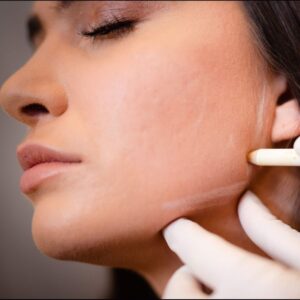Jaw Contouring: What to Expect Before and After
Jaw contouring has become a popular procedure for individuals looking to enhance their facial features, achieve a more defined jawline, or correct asymmetry. Whether through surgical or non-surgical methods, jaw contouring can lead to a more balanced, youthful appearance. If you’re considering this procedure, it’s essential to understand what to expect before, during, and after the process.
What is Jaw Contouring?
Jaw contouring is a cosmetic procedure that reshapes or enhances the jawline to create a more defined, aesthetically pleasing appearance. The treatment can be performed using either surgical methods or non-surgical alternatives, depending on the goals and the patient’s specific needs.
-
- Surgical Jaw Contouring: Involves cutting and reshaping the bone structure of the jaw. This is a more invasive procedure and usually requires a longer recovery period.
-
- Non-Surgical Jaw Contouring: Involves the use of dermal fillers, Botox, or other injectables to reshape or enhance the jawline without the need for surgery. This method is less invasive, with minimal downtime.
Before the Procedure: What to Expect
Before opting for jaw contouring, it’s essential to have a consultation with a qualified cosmetic surgeon or dermatologist. Here’s what you can expect:
-
- Initial Consultation: The consultation will involve a thorough discussion of your goals, expectations, and any concerns you may have. Your provider will assess your facial anatomy to determine whether jaw contouring is suitable for you and which method will work best.
-
- Pre-Procedure Instructions: If you choose surgery, your doctor will provide pre-surgery guidelines, which may include avoiding certain medications (like blood thinners), alcohol, and smoking. For non-surgical methods, you may be asked to avoid blood-thinning medications before the procedure.
-
- Photography and Mapping: Your provider may take photographs of your face from different angles to track progress and assist in the planning of the procedure.
-
- Risk Assessment: Discuss potential risks, complications, and the expected recovery time. It’s important to ensure that you understand all aspects of the procedure.
During the Procedure: What to Expect
Depending on the method you choose, the procedure will vary:
-
- Surgical Jaw Contouring:
-
- The procedure is typically performed under general anesthesia, so you’ll be asleep during the operation.
-
- Your surgeon will make incisions inside your mouth or under the chin to access the jawbone. The bone is then reshaped, and the jawline is contoured according to your desired look.
-
- After reshaping, the incision is closed with stitches, and you’ll be monitored in the recovery room before being sent home.
-
- Surgical Jaw Contouring:
-
- Non-Surgical Jaw Contouring:
-
- For non-surgical methods like dermal fillers or Botox, the procedure is usually done in a clinic and takes about 30 to 60 minutes.
-
- A topical numbing cream may be applied to minimize discomfort, though most patients find the process relatively painless.
-
- The injectables are strategically placed along the jawline to enhance its shape or smooth out areas of asymmetry.
-
- Non-Surgical Jaw Contouring:
After the Procedure: What to Expect
Post-procedure care is crucial to ensure the best results and a smooth recovery. Here’s what to expect after your jaw contouring:
-
- Recovery for Surgical Jaw Contouring:
-
- Pain and Swelling: You can expect some swelling, bruising, and discomfort for a few days to a week after surgery. Your doctor will likely prescribe pain medications to manage any discomfort.
-
- Follow-up Appointments: You’ll have follow-up appointments to monitor your healing process. Sutures may be removed within 1-2 weeks.
-
- Dietary Restrictions: After surgery, you’ll need to stick to soft foods for a few weeks while your jaw heals.
-
- Full Recovery: Complete recovery can take several months, but you’ll see noticeable results as swelling decreases. Scarring is minimal and often hidden within the mouth or under the chin.
-
- Recovery for Surgical Jaw Contouring:
-
- Recovery for Non-Surgical Jaw Contouring:
-
- Minimal Downtime: For non-surgical options, you can typically resume normal activities immediately after the procedure.
-
- Mild Swelling or Bruising: Mild swelling and bruising are possible but usually subside within a few days.
-
- Results: The results of dermal fillers and Botox are usually visible immediately or within a few days. However, results may take up to 2 weeks to fully settle.
-
- Touch-ups: Non-surgical procedures are temporary, and results typically last anywhere from 6 months to a year. Touch-up treatments will be necessary to maintain your desired look.
-
- Recovery for Non-Surgical Jaw Contouring:
Possible Risks and Side Effects
As with any cosmetic procedure, there are risks involved. Here are a few possible side effects to consider:
-
- Surgical Risks: Infection, nerve damage, scarring, asymmetry, or excessive swelling.
-
- Non-Surgical Risks: Bruising, swelling, lumps, or uneven results.
-
- Allergic Reactions: Though rare, some patients may experience allergic reactions to injectables.
It’s essential to choose a qualified professional to minimize risks and achieve the best results.
Is Jaw Contouring Right for You?
Jaw contouring can be a life-changing procedure, but it’s important to carefully consider your goals, budget, and expectations. If you’re looking for a more defined jawline or correcting asymmetry, jaw contouring may be the right option for you. Be sure to consult with a skilled professional to discuss the best approach for your facial features and desired outcome.
Conclusion
Whether you opt for surgical or non-surgical jaw contouring, the procedure offers a way to enhance your natural beauty and achieve a more balanced, sculpted appearance. With proper care and a skilled provider, you can expect satisfying and long-lasting results.

